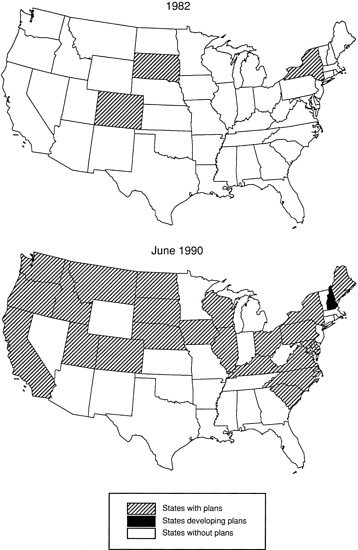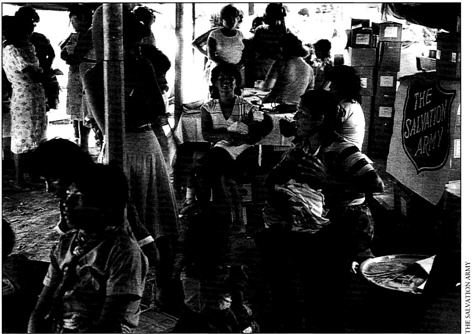CHAPTER 7
LEARNING FROM DISASTERS
Disasters are tragedies. Yet they can serve as laboratories for understanding the physical and social factors governing them. Valuable information gathered during the hours, days, months, and years following a disaster can lead to policies and practices that reduce the risk of loss of life, property, and natural resources. This information can be used to enhance the effectiveness of hazard and risk assessments, awareness and education, preparedness, prediction and warning, and mitigation.
Because disasters have both immediate and long-term impacts, postdisaster studies should be conducted so that lessons can be learned at all phases. Much information on the immediate effects of disasters on people, buildings, personal property, lifelines, economic activities, and natural resources must be gathered within the first few hours to days because evidence is rapidly lost during rescue, clean-up, and recovery. As experience has shown, however, human suffering and other damage do not end with the event itself. Thus research should focus on the complicated processes of recovery and reconstruction in the months and years following a disaster.
The postdisaster period provides the opportunity for immediate hazard reduction action in the political, legal, and administrative arenas. Immediately after a disaster, heightened awareness of damages eases the usual difficulty of adopting and enforcing hazard reduction legislation.
The Committee recommends that data on the physical, biological, social, and health aspects of disasters be systematically collected and shared and that the resulting lessons learned be incorporated into policy and practice to reduce the impacts of future disasters.
To achieve this goal, the Committee proposes that:
-
guidelines for documenting the effects of natural disasters be developed and adopted,
-
information resulting from postdisaster studies be shared, and
-
disaster reduction programs and legislation be developed for rapid implementation after an event.
A program for enhancing the nation's capabilities to learn from disasters should include:
-
Postdisaster data acquisition. Efforts should be made to coordinate and standardize the type of data collected by postdisaster investigation teams. Data should relate to the physical, biological, and social phenomena leading to the disaster; numbers and patterns of injuries and deaths; performance of buildings and lifelines; and response of individuals and organizations. Successful efforts to reduce damage and loss of life should also be included.
During the past few decades, the National Research Council, the Earthquake Engineering Research Institute, the Centers for Disease Control, OFDA, and other public and private organizations have sent multidisciplinary teams to analyze the immediate impact of disasters throughout the world. Extending this practice to all presidentially declared disasters should be considered. Academic researchers and others have conducted a few intermediate-term studies, focusing on recovery and reconstruction in
the first few years. Additional studies of this process would provide valuable lessons for improving hazard assessments, mitigation, disaster planning, recovery, and reconstruction. (See Figure 4.) Also needed is long-term research on the effects of disasters 10 or more years after their occurrence.
Coordination of the type of data collected and the format in which it is presented would enhance all these research efforts. Databases and analysis programs should be improved to facilitate the collection and sharing of information, the translation of lessons learned into improved disaster preparedness and mitigation measures, and their transfer to policymakers and practitioners.
It is important that data be collected immediately after a disaster. Still more important is that rescue, relief, and clean-up operations not be hindered by the convergence of investigation teams. Experience shows that the arrival of many teams can divert local officials from the job of disaster response and recovery to that of reluctant host. Clearly, agreements should be made to ensure that disaster sites are not overrun by investigators.
Workshops should be held to develop guidelines on the acquisition, analysis, and use of data from postdisaster investigative teams and to establish agreements for mobilizing these teams. In the United States, workshops may be organized under the auspices of universities, professional associations, and others. At the international level, they can be implemented through relevant UN system organizations — the IDNDR Secretariat, UNESCO, the World Meteorological Organization (WMO), the World Health Organization (WHO), the United Nations Development Programme (UNDP), the Office of the UN Disaster Relief Co-ordinator, and other bodies. Guidelines should be reviewed periodically and revised as appropriate.
-
Postdisaster data sharing. Information is useful when it is shared and applied, and mechanisms for exchanging information from postdisaster analyses and other research are needed. Because major disasters in any one nation are infrequent, international cooperation is necessary to derive the benefits of the volume of knowledge and experience that can be gained only by working in the global laboratory.
Sharing postdisaster data increases their potential to help improve disaster reduction practices, particularly when disciplines come together. Geologists, geophysicists, seismologists, architects, engineers, biologists, sociologists, urban planners, financial institutions, public officials, and medical personnel working together are more likely to devise practical natural hazard reduction strategies than would any of these groups acting singly.
National and international sharing of postdisaster information should be accomplished through news releases, briefings, newsletters, conferences, workshops, and other means. Sponsors of these activities should include organizations involved in both research and application.
-
Capitalizing on enhanced awareness. A disaster brings risk reduction to the forefront of community priorities. Public sensitivity to the risks associated with natural hazards is especially high for about six months after a major event. This awareness leads to a corresponding will to take life- and property-saving actions. The postdisaster environment also brings public officials face to face with liability issues. As a result, political support for preparedness and mitigation programs increases during this time — the introduction and implementation of all types of hazard reduction policies and practices become possible.
This brief opportunity cannot be bypassed. Concerned individuals, professional and community groups, and policymakers must be ready. Hazard information and proposed legislation, regulations, and enforcement guidelines should be prepared in advance, using the lessons from postdisaster investigations and other research. Plans should be made for rapid incorporation of experience into the decision-making process.
Model legislation and guidelines for incorporation of disaster reduction into community practice should be developed. Professional organizations such as the American Bar Association, the American Society for Public Administration, the American Public Works Association, and the American Planning Association should establish task forces to develop and disseminate these models. Local task forces should adapt them to the risks and characteristics of their communities and devise strategies for promoting them at the first opportunity.

Figure 4. CHANGES IN THE STATUS OF DROUGHT PLANNING, 1982-90
A 1982 survey of all 50 states showed only 3 with drought plans. The droughts of 1986-88 gave states a new appreciation of their vulnerability to severe water shortages and the effects of their poorly coordinated responses. By June 1990, 23 states had plans and another had begun the planning process. (Source: D. Wilhite, International Drought Information Center.)

The first few days after a disaster see the influx of relief efforts — volunteers, government assistance, and organized private voluntary organizations. A strong working knowledge of the area struck is needed to ensure that appropriate supplies are delivered and that the special needs of the community — such as possible cultural or language barriers — are anticipated.




